#Crisford #Norris #History #Patent #Drawings #Patents
.
This firm of manufacturing silversmiths was active from 1896 – 1959, when it was acquired by Ward Brothers (Birmingham) Ltd. The business premises of Harold Crisford & William Clement Norris were located at 117-118 Vyse Street in the heart of the Birmingham jewellery quarter. The company is noted for its high quality luxury pieces which include babies rattles, bookmarks, boxes, button hooks, card cases, powder compacts, match box holders, napkin rings, pepperettes, shoe horns, spoons, stamp cases and trophy cups.
As you would expect, the company premises and employees were given over to war work during both world wars.
We can see from the entry in the 1918 directory listing below that during WWI the company made many many different items for the war effort.
In WWI & WWII it is usual for the number of female employees to be much greater than male staff, as the men would be away fighting.
COMPANY DETAILS WAR WORK PEACETIME WORK
1918 DIRECTORY OF MANUFACTURERS IN ENGINEERING AND ALLIED TRADES
From the information listed below we can see that this maker was crafting powder compacts for use with either pressed or loose foundation.
This maker’s entry in the 1929 British Industries Fair catalogue entry reads as follows:
Listed Exhibitor British Industries Fair as manufacturers of:
Silver Baby Rattles. Silver Ladies’ Compact and Loose Powder Boxes. Silver and E.P.N.S. Manicure Cases and Stands. Silver Prize Cups and Patent Grip Attachments. Fancy articles and novelties. Birmingham Jewellers’ and Silversmiths’ Association Member. (Stand Nos. J.43 and J.54).
We can see from this listing that the firm was involved in the creation of manicure cases & dressing sets. These sets would have included shoe horns, button hooks, nail buffers, nail files, cuticle pushers, scissors and powder jars.
These sets were presented in elegant wooden cases clad in black leather and fitted with ornate gilded brass catches. The interior lids were lined with silk which was sometimes stamped with the maker’s name in gilt lettering. The interior bases were fitted with a carved wooden stand with custom made recesses for each item. This wooden stand was clad in velvet. The preferred and most practical colours for the silk and velvet linings were royal blue, crimson or garnet red.
The most ornate sets may have had subtle hand tooled decorations on the leather cladding. Sometimes the hand tooled decorations would have been embellished with gold accents.
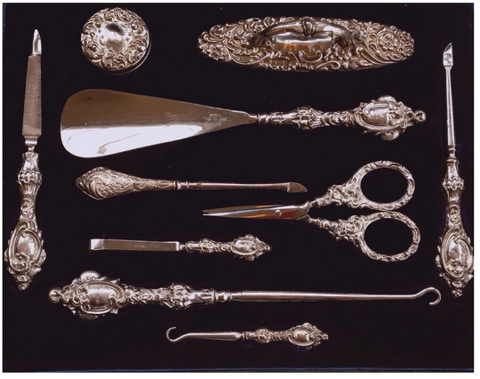
ANTIQUE STERLING SILVER DRESSING SET
Less expensive versions of the sterling silver sets were made from E.P.N.S. (electroplated nickel silver). The repoussage work on these sets would often be as ornate as the hallmarked silver sets.
Sets crafted in fully hallmarked sterling silver would often be as ornate as the set shown above. The shafts of the nail files, button hooks, shoe horns etc were made from steel, which was used for its strength.
The listing also informs us that this firm was commissioned to craft stylish sporting trophies.
On August 17 1926 William Clement Norris submitted his design for a plinth.
Here the inventor describes his invention:
A further object of the present invention is to provide a fastening means which will be invisible when the cup or other ornament is mounted upon the plinth or base.
A further object of the present invention is to provide fastening means which, while it constitutes a secure attachment and prevents the ornament from being damaged by being knocked of the base or plinth, yet permits of the ornament being easily removed from the base or plinth for cleaning purposes when desired.
PATENT NO. 276143
PATENT NO. 276143
On March 30 1928 Walter Clement Norris submitted an application to patent Improvements in Powder Boxes.
We have included the first page of this patent application to show the design features Norris sought to patent. The end result was a removable powder plate which would prevent powder from leaking into the main part of the compact and obscuring the mirror.
PATENT NO. 313673
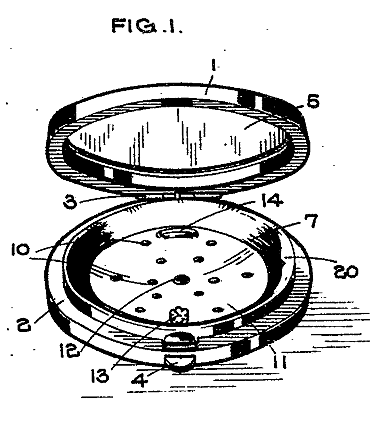
PATENT NO. 313673
Figure 1 is a perspective view of the powder box open.
The numbers represent lid (1), base (2), hinge (3), releasable retaining catch (4),
mirror (5), removable cover (7), holes to allow the release of powder (10), partially rotated shutter to prevent or allow the release of powder (11), 11 is loosely rivetted to the centre of the cover (12), a projection (13) which allows the operation of the loosely rivetted cover to be moved to open or shut the device to allow or prevent loose powder from escaping. An arc like projection (14) limits the movement of the shutter (11). A finger grip (20) facilitates the removal of the inner receptacle.
The projection / knob (13) is formed to resemble a tiny flower.
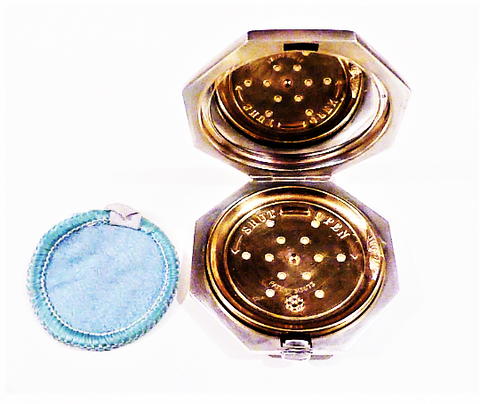
PATENT NO. 313673 CRISFORD & NORRIS STERLING SILVER COMPACT
The detachable inner lid is stamped with instructions about how to use this patented device. On the left ‘SHUT’ & the right ‘OPEN’ & a little flower shaped projection (13) to push to activate the mechanism. On the right there is a handle / finger grip (20) that you hook to remove the powder well entirely. Just above the flower projection (13) the inner lid is stamped PATENT 313673.
The compact shown below is made from fully hallmarked sterling silver. This vanity was assayed at Birmingham in 1931. The removable powder dispenser is made from brass.
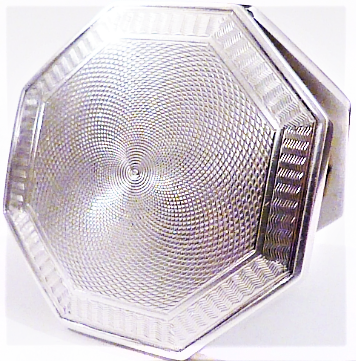
STERLING SILVER CRISFORD & NORRIS LOOSE POWDER COMPACT

C & N (THE MARK OF CRISFORD & NORRIS)
Under the maker’s mark we see the anchor which represents Birmingham Assay Office. Next the lion passant mark denotes sterling silver. This font of upper case G stamped in this style of cartouche stands for 1931
This maker is especially well known for their vanities and baby rattles.
As you can see from the patent drawing below, Crisford & Norris baby rattles are particularly charming.
PATENT NO. 359172
PATENT NO. 359172
Crisford & Norris war work in WWI & WWII would also include the crafting of luxury accessories for officers’ wives.
The example below gives a good indication of the quality of these highly collectible vanities.
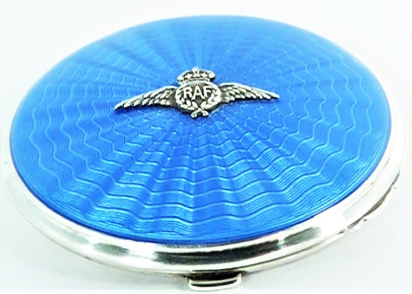
An elegant and dainty Crisford & Norris Art Deco compact mirror which is embellished with splendid Air Force Blue enamel. Set atop the lid is a finely engraved sterling silver pilot’s flying badge. A double thumb catch ensures ease of opening. This piece was assayed at Birmingham in 1937.
View more elegant hallmarked silver compact mirrors.

ART DECO CRISFORD & NORRIS VANITY 1939
This enchanting vanity was designed for use with loose face powder or as a handbag mirror. The excellent guilloche enamel lid is adorned with the most quintessentially English wild flower, the Dog Rose. The popularity of embellishments which include Dog Roses dates back hundreds of years. The Academy of Floral Games gifted a sprig of Dog Rose to poets who displayed considerable literary merit. This ancient ritual inspired many references to this flower in poems and plays, including those written by William Shakespeare. The Dog Rose is also known as the wild rose, briar or witches briar.
The guilloche enamel depicts the well known highly stylised Art Deco sunrise.
At the bottom we can see the semi-circle of the rising sun.
Emanating from the sun are powerful rays.
In October 1941 the firm’s business premises at 117 – 118 was completely destroyed by the Luftwaffe.
As we can see from the outstandingly beautiful compact shown below, the company continued in business.
Like much of the Birmingham Jewellery Quarter and industrial areas of Great Britain, the owners and their employees salvaged what they could from the bombed out buildings and began to support the war effort with great resilience and dedication.
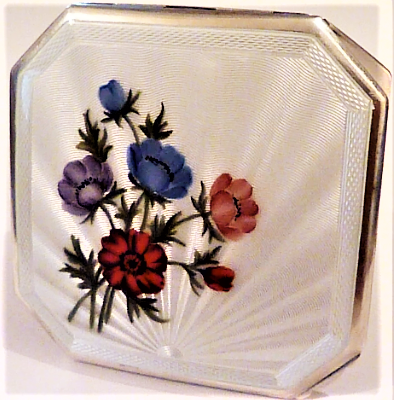
CRISFORD & NORRIS STERLING & GUILLOCHE ENAMEL COMPACT
A very beautiful sterling silver powder compact which is embellished with flawless guilloche enamel. The white guilloche enamel is decorated with hand painted flowers. This compact was assayed at Birmingham Assay Office in 1956.
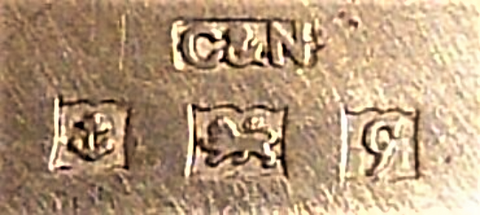
THE MARK OF CRISFORD & NORRIS
This hallmark has a gilded appearance. Crisford & Norris were one of the many firms that used the process of electrolysis to bond a layer of gold onto the interior cases of their sterling silver vanities. The vermeil finish is aesthetically pleasing and forms a protective coat which prevents the sterling silver from tarnishing.
View more wonderful hallmarked silver compacts.
Sources:
Patent Office.
Birmingham Assay Office.
Directory of Manufacturers in Engineering & Allied Trades.



